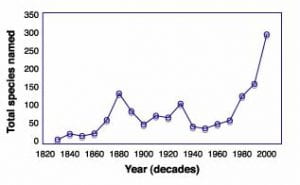How taxonomic revisers work
To many biologists, there is nothing more exciting than discovering (and naming) a new species. To others, there is no greater joy than discovering a synonym or other error, and so having the opportunity to tidy up a previously confusing situation.
The revisers, the biologists and palaeontologists who reexamine earlier work and identify synonyms or incorrectly established taxa, operate in three modes that reflect normal working practices: background, monographic, and catalogue. These correspond to rising levels of invalidation, as the systematist is obliged to make increasingly comprehensive and clear-cut decisions.
- Background mode covers normal publications in which occasional comments are made about earlier work. In describing a new species or reviewing a fauna, a systematist may cast doubt on some former names, or make modest revisions. Difficult decisions about the validity of earlier taxa may be avoided.
- In monographic mode, a systematist undertakes to review a clade, perhaps a family, and is obliged then to make decisions that might otherwise be avoided when in background mode. In a monographic overview, the systematist has to consider all previously established names for members of the clade of interest and make decisions about the validity of each.
- In catalogue mode, the systematist is committed to reviewing a clade and producing a book or substantial monograph. Cataloguers often do not examine original material and list everything without comment, relying on the authority of previous workers. More recent catalogers (e.g., authors in Weishampel et al. 1990, 2004) have looked at everything, or nearly everything, and have made clear decisions about each taxon. Indeed, in these volumes the standard view was to accept most previously published proposals of synonymy, and to shift large numbers of taxa to the nomen nudum and nomen dubium lists following simple rules of thumb (“if it’s based on a single tooth, it’s a nomen dubium”). The approach is firm, but acceptable to most workers in the field; had the catalogues not been produced, however, many of these decisions would have been avoided and dubious taxa might still remain on the lists of valid taxa.

Number of species of dinosaurs named each year, from 1824 to the present day, counted in ten-year cohorts. The current total is 1401 species – although more than half of these are now regarded as invalid.
The balance between naming and revision
Tracking through research time (see Figure above), new dinosaurs were named at a rate of 0-5 per year through much of the nineteenth and early twentieth centuries (0-2 per year from 1824 to 1850, 3-4 per year from 1851 to 1900, 3-4 per year from 1901 to 1980, 20-30 per year from 1980), with highs of 10-20 in 1876 and 1877, corresponding to intense activity by Edward Cope and Othniel Marsh, and 1914, 1932, and 1933, mainly from publications by Friedrich von Huene. Current annual totals are the highest ever, with some 20-30 new genera being named per year – one every two weeks.
For Dinosauria, invalidations and revalidations sometimes happened promptly, within a year or two of the naming of the genus; at other times it took decades or centuries for such decisions to be published. The movement in the numbers of taxa considered valid at any time is not smooth, however, and depends on the publication of major review monographs. There may be several years, or even a decade, during which little revision is carried out, and the curve of accepted taxa keeps rising as new species and genera are named. Then, a synoptic review, such as The Dinosauria or The Dinosauria 2 (Weishampel et al. 1990, 2004) may be published, and this produces a dramatic reduction in accepted taxa at a stroke.
In summarizing the totals of valid species through time, it is important to distinguish between “then valid” and “now valid” totals. The “then valid” total documents opinions at the time, and is suitable for a study of changing opinion through time (Alroy 2002). This approach has further merit in answering concerns about how knowledge accumulates and whether the accumulation of knowledge changes our big-picture view of evolution. The “now valid” total maps today’s opinion back in time, and this gives a clearer picture of how current knowledge accumulated.
Read more about the study
- Error in naming dinosaurs
- Naming organisms and biodiversity
- Naming and revision
- The dinosaur discovery curve
- (With all the money in the world) How to find new dinosaurs
- Who named most dinosaurs?
- Are we getting any better at it?
- Home – dinosaur names, error, and biodiversity
References
- Alroy, J. 2002. How many named species are valid? Proceedings of the National Academy of Sciences USA 99, 3706-3711.
- Weishampel, D. B., P. Dodson, and H. Osmólska, eds. 1990. Dinosauria. University of California Press, Berkeley.
- Weishampel, D. B., P. Dodson, and H. Osmólska, eds. 2004. Dinosauria, 2nd ed. University of California Press, Berkeley.

